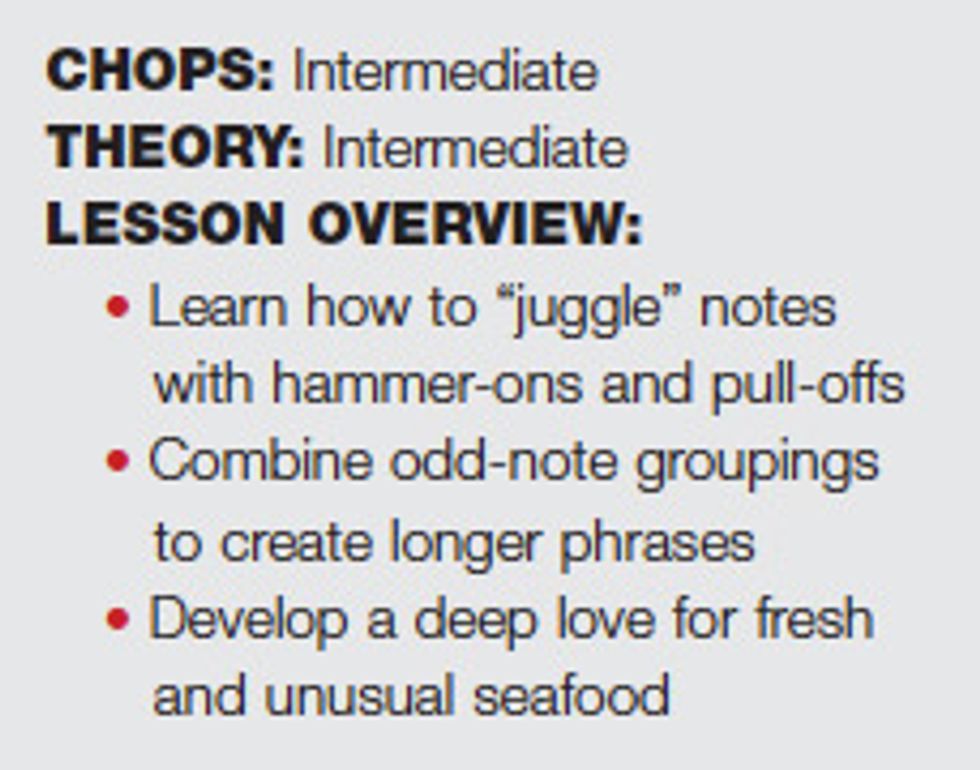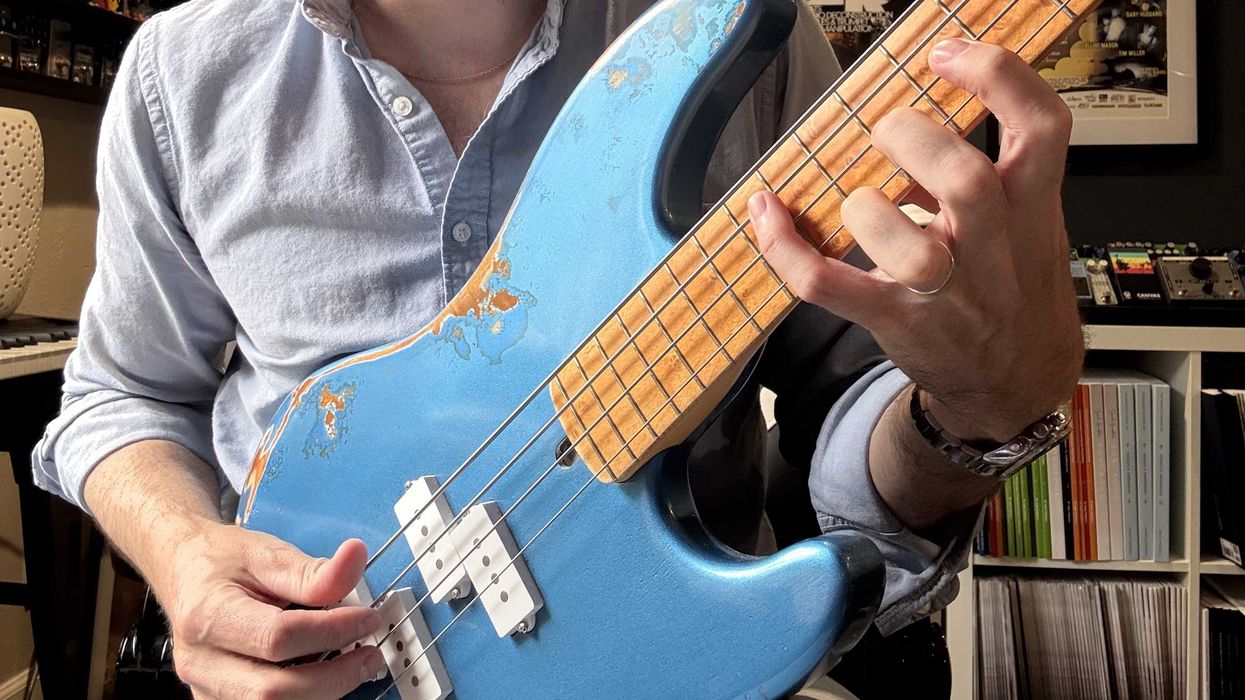Do you ever find yourself in a conversation
about trying strange and exotic
food? Everyone seems to have sampled
something strange at one point or another.
For example, it could be chocolate covered
creepy-crawlies, crunchy deep-fried hopping
or chirping things, large African bird eggs,
fish eyes, chicken hearts, pig brains, or even
cow tongues. There are so many culinary
adventures available to us to try. What a
wonderful world.
I like this kind of adventure. But I’m more interested in a subcategory of strange food, and that is: Strange Food I’d Purposefully Seek Out Again and Again Because It’s Genuinely Delicious. One of my favorites in this category is squid. While it’s still alive that is—it doesn’t get any fresher than that! The squid tastes fantastic, and it’s fun to think I’m experiencing the same thing that a blue shark eats every day.
I get excited about fresh, good things, whether they are edible or musical. The following phrases are so fresh to me, if they had legs they would still be wiggling around in the air.
Let’s start with an easy one. Fig. 1 is a G# diminished 7th arpeggio (G#–B–D–F). Since a diminished arpeggio consists of four notes that are all equidistantly spaced, we can consider any note the root. I like it for its geometrically appealing shape, and its serious, furrowed-brow sound. It’s important to visualize the shape before we dive into the notes.

Now that we have a general idea of where our fingers will go, let’s apply the phrase in Fig. 2. I am hearing this phrase as 16th notes, but you will notice groups of five within a phrase. I like how this creates slightly unpredictable accents. I also made it a point to end on a strong beat with enough time to sustain and do some vibrato.
or download example audio

At this point, I want to insert some advice on technique.
I recommend you not pick every note. It’s important to dispel the myth that good technique requires every note to be picked. There are so many phrases that I love— including the ones in this column—where picking every note would cripple the phrase. It would be like trying to juggle three balls while keeping a hand on each ball at all times—we just can’t do it (but perhaps a squid could be trained for this trick).
By imitating a juggler, you allow some of the notes to “float,” and this gives your picking hand more free time to relax and choose the most comfortable picking strokes. But like juggling, this technique requires practice and coordination. The good news: It’s “easy once you get it.” By this, I mean it doesn’t require brute force or arm-stiffening “motorboat” picking. If coordinated properly, it will flow easily and smoothly with very little physical effort.
So what is the first step of this “juggling” technique?
Let’s start with the idea that your first note is always picked, and every note that follows will fall into one of these two categories:
Now here is the big payoff. Looking at these two categories will tell you what your pick should do. Here’s how it works:
All right, let’s get back to the music. After you’ve spent some time digesting the diminished phrase at the beginning of this column (I recommend playing it for at least a week or so), you can start altering the shapes to get some different arpeggios and scales. Please plunge your fingers into the included examples and see what you can pull out.
At first, all these new arpeggios and scales might seem like a lot to chew on, but once you master any one of them, you’ll be surprised how easily the others will fall into place. They are all built from the same underlying phrase, so your fingers will adapt to the new shapes with minimal work.
I thank you. I thank the chef. And I thank the squid.
or download example audio

or download example audio

or download example audio

or download example audio

or download example audio

or download example audio

or download example audio

 Paul Gilbert purposefully began playing guitar
at age 9, formed the guitar-driven bands
Racer X and Mr. Big, and then accidentally
had a No. 1 hit with an acoustic song called
“To Be with You.” Paul began teaching at
GIT at the age of 18, has released countless
albums and guitar instructional DVDs, and
will remembered as “the guy who got the drill
stuck in his hair.” For more information, visit
paulgilbert.com.
Paul Gilbert purposefully began playing guitar
at age 9, formed the guitar-driven bands
Racer X and Mr. Big, and then accidentally
had a No. 1 hit with an acoustic song called
“To Be with You.” Paul began teaching at
GIT at the age of 18, has released countless
albums and guitar instructional DVDs, and
will remembered as “the guy who got the drill
stuck in his hair.” For more information, visit
paulgilbert.com.
I like this kind of adventure. But I’m more interested in a subcategory of strange food, and that is: Strange Food I’d Purposefully Seek Out Again and Again Because It’s Genuinely Delicious. One of my favorites in this category is squid. While it’s still alive that is—it doesn’t get any fresher than that! The squid tastes fantastic, and it’s fun to think I’m experiencing the same thing that a blue shark eats every day.
I get excited about fresh, good things, whether they are edible or musical. The following phrases are so fresh to me, if they had legs they would still be wiggling around in the air.
Let’s start with an easy one. Fig. 1 is a G# diminished 7th arpeggio (G#–B–D–F). Since a diminished arpeggio consists of four notes that are all equidistantly spaced, we can consider any note the root. I like it for its geometrically appealing shape, and its serious, furrowed-brow sound. It’s important to visualize the shape before we dive into the notes.
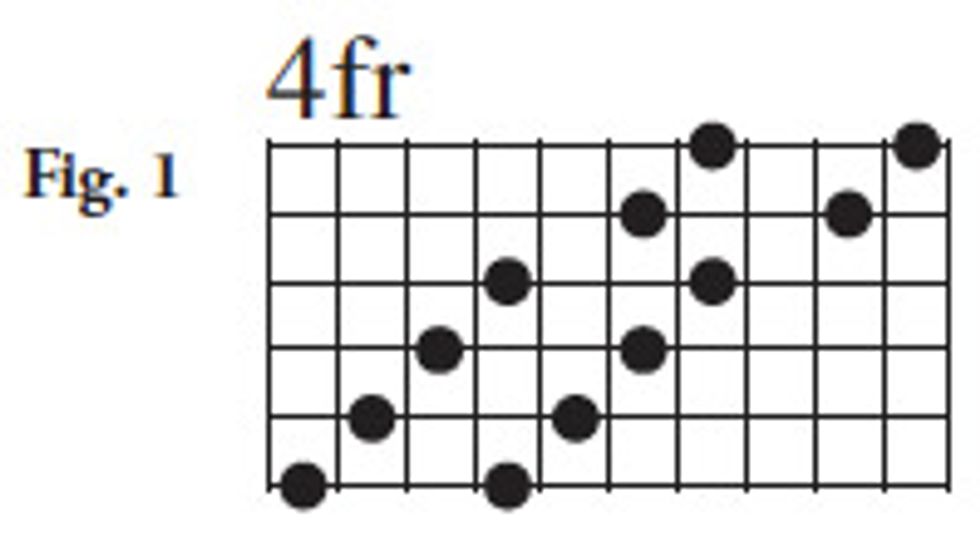
Now that we have a general idea of where our fingers will go, let’s apply the phrase in Fig. 2. I am hearing this phrase as 16th notes, but you will notice groups of five within a phrase. I like how this creates slightly unpredictable accents. I also made it a point to end on a strong beat with enough time to sustain and do some vibrato.
or download example audio
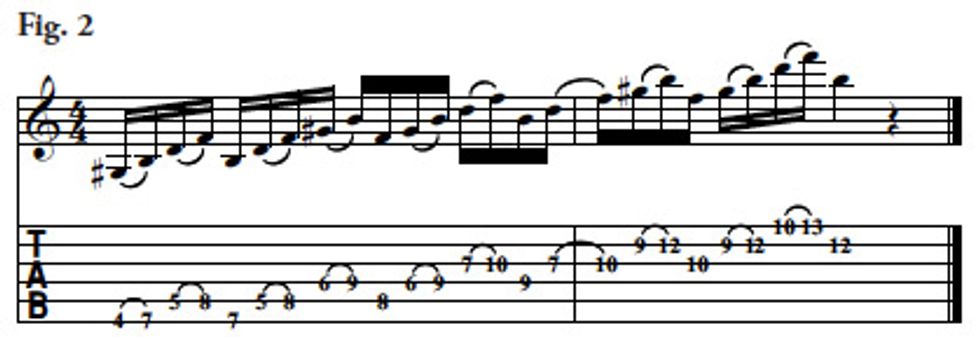
At this point, I want to insert some advice on technique.
I recommend you not pick every note. It’s important to dispel the myth that good technique requires every note to be picked. There are so many phrases that I love— including the ones in this column—where picking every note would cripple the phrase. It would be like trying to juggle three balls while keeping a hand on each ball at all times—we just can’t do it (but perhaps a squid could be trained for this trick).
By imitating a juggler, you allow some of the notes to “float,” and this gives your picking hand more free time to relax and choose the most comfortable picking strokes. But like juggling, this technique requires practice and coordination. The good news: It’s “easy once you get it.” By this, I mean it doesn’t require brute force or arm-stiffening “motorboat” picking. If coordinated properly, it will flow easily and smoothly with very little physical effort.
So what is the first step of this “juggling” technique?
Let’s start with the idea that your first note is always picked, and every note that follows will fall into one of these two categories:
- The next note is on a different string.
- The next note is on the same string.
Now here is the big payoff. Looking at these two categories will tell you what your pick should do. Here’s how it works:
- When the next note is on a different string, PICK IT.
- When the next note is on the same string, DON’T PICK IT. Use a hammer- on or a pull-off instead.
All right, let’s get back to the music. After you’ve spent some time digesting the diminished phrase at the beginning of this column (I recommend playing it for at least a week or so), you can start altering the shapes to get some different arpeggios and scales. Please plunge your fingers into the included examples and see what you can pull out.
At first, all these new arpeggios and scales might seem like a lot to chew on, but once you master any one of them, you’ll be surprised how easily the others will fall into place. They are all built from the same underlying phrase, so your fingers will adapt to the new shapes with minimal work.
I thank you. I thank the chef. And I thank the squid.
or download example audio
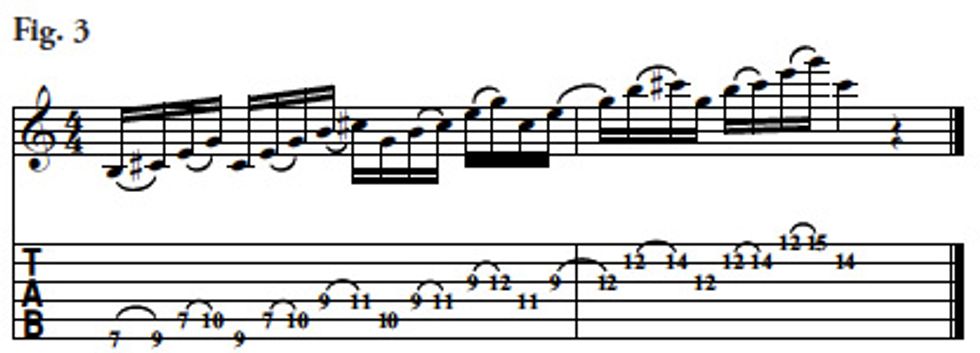
or download example audio

or download example audio

or download example audio

or download example audio

or download example audio

or download example audio

 Paul Gilbert purposefully began playing guitar
at age 9, formed the guitar-driven bands
Racer X and Mr. Big, and then accidentally
had a No. 1 hit with an acoustic song called
“To Be with You.” Paul began teaching at
GIT at the age of 18, has released countless
albums and guitar instructional DVDs, and
will remembered as “the guy who got the drill
stuck in his hair.” For more information, visit
paulgilbert.com.
Paul Gilbert purposefully began playing guitar
at age 9, formed the guitar-driven bands
Racer X and Mr. Big, and then accidentally
had a No. 1 hit with an acoustic song called
“To Be with You.” Paul began teaching at
GIT at the age of 18, has released countless
albums and guitar instructional DVDs, and
will remembered as “the guy who got the drill
stuck in his hair.” For more information, visit
paulgilbert.com.